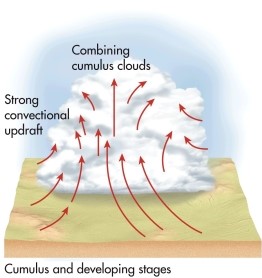A) mA and mC
B) cT and cP
C) mE and cA
D) mT and cP
F) A) and B)
Correct Answer

verified
Correct Answer
verified
True/False
The amount of cloud cover and precipitation associated with occluded front is usually less than with either the warm front or the cold front.
B) False
Correct Answer

verified
Correct Answer
verified
Multiple Choice
As the center of a hurricane passes from the south to the north of a location in the Northern Hemisphere,the winds will usually shift from the
A) south to still to north.
B) southeast to southwest to northwest.
C) east to still to west.
D) northwest to south to northeast.
E) west to still to southeast.
G) A) and E)
Correct Answer

verified
Correct Answer
verified
True/False
A warm and moist air mass is called cT.
B) False
Correct Answer

verified
Correct Answer
verified
True/False
The slope of a warm front is steeper than a cold front.
B) False
Correct Answer

verified
Correct Answer
verified
Multiple Choice
The following diagram represents which stage of thunderstorm development? 
A) mature
B) cumulus
C) dissipating
D) stationary
E) occlusion
G) None of the above
Correct Answer

verified
Correct Answer
verified
Multiple Choice
Supercell thunderstorms can produce tornadoes due to large rotating updrafts called
A) mesocyclones.
B) Doppler shift.
C) microcyclones.
D) macrocyclones.
F) C) and D)
Correct Answer

verified
Correct Answer
verified
Short Answer
Hurricane Katrina reached a maximum of a Category __________ storm.
Correct Answer

verified
5
Correct Answer
verified
True/False
When tornadoes occur,they usually are found in the front of a severe thunderstorm.
B) False
Correct Answer

verified
Correct Answer
verified
Multiple Choice
In the United States,with the passage of a typical warm front
A) temperatures drop.
B) a day of slow but steady precipitation ends.
C) clouds begin to get lower and thicker.
D) the winds will flow from the north.
E) the air mass will always be a cP.
G) All of the above
Correct Answer

verified
B
Correct Answer
verified
Short Answer
The fastest wind speeds that naturally occur on Earth are located inside a __________.
Correct Answer

verified
Correct Answer
verified
Multiple Choice
The air mass that is the main source of precipitation in the eastern United States is the
A) cP.
B) cT.
C) mT.
D) mP.
E) cA.
G) A) and C)
Correct Answer

verified
Correct Answer
verified
Multiple Choice
Which of the following statements are true about tornado detection and warnings?
A) Traditionally, when the very first tornado from a storm system develops, the condition in effect from the National Weather Service is a tornado watch.
B) A tornado warning is only issued once an actual funnel or tornado has been identified.
C) A hook echo is the diagnostic feature in radar that indicates strong rotation within a thunderstorm and possible tornado development.
D) NEXRAD is a network of anemometers that allow the National Weather Service to track tornado wind speeds.
E) Doppler radar technology allows tornado warnings to be issued faster and with greater accuracy.
G) B) and D)
Correct Answer

verified
A,B,C,E
Correct Answer
verified
Multiple Choice
Which of the following are characteristics of a thunderstorm?
A) Severe thunderstorms are typically accompanied by abundant lightning.
B) Most thunderstorms are very intense events.
C) Thunderstorm strength is measured on the Enhanced Fujita scale.
D) The most intense thunderstorms may contain tornadoes that have incredibly strong winds that can cause great damage.
E) Most thunderstorms are short-lived events.
G) A) and D)
Correct Answer

verified
Correct Answer
verified
True/False
The greatest damage of a hurricane is usually from the high winds.
B) False
Correct Answer

verified
Correct Answer
verified
Multiple Choice
Which of the following are true about Hurricane Sandy?
A) It caused 0.6 m (2 ft) of snow to fall in some inland areas because it combined with an early winter storm.
B) It was the costliest storm in U.S. history.
C) It struck the East Coast at precisely the highest tide of the month, which led to a 4-m-high (13-ft-high) storm surge in parts of northern New Jersey and New York City.
D) The hurricane was drawn to the west by a strong midlatitude surface low, causing it to form a superstorm that extended over 1000 km (600 mi) in width.
E) When the levees near New Orleans failed, some parts of the city were flooded with several meters of water.
G) C) and D)
Correct Answer

verified
Correct Answer
verified
True/False
A cold front is characterized by thunderstorms.
B) False
Correct Answer

verified
Correct Answer
verified
Multiple Choice
A brief but strong storm that contains strong winds,lightning,thunder,and sometimes hail is a(n)
A) hurricane.
B) nimbostratus cloud.
C) midlatitude cyclone.
D) thunderstorm.
E) storm surge.
G) B) and E)
Correct Answer

verified
Correct Answer
verified
True/False
The slowest moving front of an occluded stage midlatitude cyclone is the warm front.
B) False
Correct Answer

verified
Correct Answer
verified
Multiple Choice
The repeated pull of ice crystals back into the upper part of a thunderstorm until they become too large to be supported produces
A) hail.
B) NEXRAD.
C) streamers.
D) a willy nilly.
E) a gale.
G) B) and D)
Correct Answer

verified
Correct Answer
verified
Showing 1 - 20 of 141
Related Exams